Do you have a sales plan? Entrepreneurs, sales executives, and sales managers all benefit from writing sales plans — whether for their business, department, or team. You must know where you’re going before you can hit your key targets, and from there, you must break down the strategies and tactics you’ll use to do it.
All of this information can be included in a sales plan (and more). Read on to learn how you can get a sales plan that’s right for your organization drafted and on paper.
In this post, we’ll cover:
- What Is a Sales Plan?
- What Is the Sales Planning Process?
- What Goes In a Sales Plan Template
- How to Write a Sales Plan
- Strategic Sales Plan Examples
Sales plans often include information about the business’ target customers, revenue goals, team structure, and the strategies and resources necessary for achieving its targets.
An effective sales plan should do the following:
- Communicate your company’s goals and objectives to your sales team.
- Provide strategic direction for your sales team.
- Outline roles and responsibilities for your sales team and leadership.
- Monitor your sales team’s progress to organizational goals.
Sales Planning Process
One thing to keep in mind, though, is that sales planning doesn’t just encompass the creation of a sales plan document. In order for that document to be more than something that gathers dust on the bookshelf, high-level strategy is required:
- Gather sales data from the previous year and search for trends.
- Define your objective and create sales targets that meet your revenue goals.
- Determine the metrics that will be used to gauge success.
- Assess your current situation, including weaknesses that will act as roadblocks and strengths that will help.
- Start sales forecasting based on demand trends and historical data.
- Identify any gaps that need to be filled to achieve your targets.
- Ideate new initiatives based on opportunities you may have passed on in previous years.
- Involve stakeholders from departments that affect your outcomes such as Marketing and Product.
- Outline action items based on capacity and quota numbers.
One thing to keep in mind is that sales planning shouldn’t end with the creation of the document. You’ll want to reiterate this process every year to maintain your organization’s sales excellence. Now that you’re committed to the sales planning process, let’s dive into the written execution component of sales planning.
Sales Plan Template
Ready to write your own plan? Download HubSpot’s Free Sales Plan Template to get started. A typical sales plan includes the following sections:
- Target customers — Who your company aims to serve with its products and services.
- Revenue targets — How much revenue your team aims to bring in each period.
- Strategies and tactics — The specific actions your team will take to reach revenue targets.
- Pricing and promotions — Documentation of your offering’s prices and any upcoming promotions that can convert customers.
- Deadlines and DRIs (Directly Responsible Individuals) — Outline any important dates for deliverables and list who is accountable for their completion.
- Team structure — Who is on your team, and what their role is.
- Resources — The tools your team uses to reach revenue targets.
- Market conditions — Pertinent information about your industry and the competitive landscape.
Now let’s walk through how to write a sales plan – and don’t forget to follow along with HubSpot’s free Sales Plan Template to make the most of this blog post.
1. Mission and Background
Begin your sales plan by stating your company mission and vision statements. And write up a brief history of the business — this will provide background information as the plan drills down into more specific details.
2. Team
Next, describe who is on your team and what their roles are. Perhaps you manage five salespeople and work closely with a sales enablement professional and a sales ops specialist.
If you’re planning on adding headcount, include the number of employees, their job titles, and when you’re planning to bring them on the team.
3. Target Market
Whether you’re writing your first sales plan or your fifteenth, knowing your target demographic is crucial. What do your best customers look like? Do they all belong to a specific industry? Exceed a certain size? Struggle with the same challenge?
Keep in mind you might have different buyer personas for different products. For example, HubSpot salespeople might primarily sell marketing software to CMOs and sales software to sales directors.
This section of your sales plan can also change dramatically over time as your solution and strategy evolves and you find product-market fit. In the very beginning, when your product was in its infancy and your prices were low, you may have found success selling to startups. Now that the product is far more robust and you’ve raised the price, mid-market companies are likely a better fit. That’s why it’s important to consistently review and update your personas.
4. Tools, Software, and Resources
You should also include a description of your resources. Which CRM software do you plan on using? Do you have a budget for sales contests and incentives?
This is where you’ll lay out which tools your salespeople should use to succeed in their jobs (e.g., training, documentation, sales enablement tools, etc.).
5. Positioning
Now, name your competitors. Explain how your products compare, where theirs are stronger than yours, and vice versa. In addition, discuss their pricing versus yours.
You should also discuss market trends. If you’re a SaaS company, you should note vertical-specific software is becoming more popular. If you sell ads, mention the rise in programmatic mobile advertising. Try to predict how these changes will influence your business.
6. Marketing Strategy
In this section, describe your pricing and any promotions you’re planning on running. What key actions will you take to increase brand awareness and generate leads? Note the impact on sales.
Here’s a mock version:
- Product A: Increasing price from $40 to $45 on Feb. 2 (2% reduction in monthly sales)
- Product B: Free upgrade if you refer another customer from Jan. 1-20 (20% increase in monthly sales)
- Product C: Decreasing price from $430 to $400 on March 1 (15% increase in monthly sales)
- Product D: No change
7. Prospecting Strategy
How will your sales team qualify the leads that are generated by your marketing strategy? Don’t forget to include the criteria prospects should meet before sales reps reach out.
And identify which inbound and outbound sales methods your team will use to close more deals.
8. Action Plan
Once you’ve outlined where you want to go, you must figure out how you’ll get there. This section summarizes your game plan for hitting your revenue targets.
Here are a few examples:
1. Objective: Increase referral rates by 30% this quarter
- Run three-day referral techniques workshop
- Hold sales contest for referral sales
- Increase commission on referral sales by 5%
2. Objective: Acquire 20 Enterprise logos
- Identify 100 potential prospects and assign a tiger team to each
- Hold two executive-level events
- Give a bonus to the first team to win three logos
9. Goals
Most sales goals are revenue-based. For example, you might set a total target of $10 million in annual recurring revenue (ARR).
Alternatively, you can set a volume goal. That could be 100 new customers or 450 sales. Make sure your objective is realistic, otherwise your entire sales plan will be largely useless.
Factor in your product’s price, total addressable market (TAM), market penetration, and resources (including your sales headcount and Marketing support).
Your goal should also be closely tied to your high-level business goals; to give you an idea, if the company is trying to move upmarket, your goal might be “Acquire 20 Enterprise logos” rather than “Sell X in new business” (because the former will encourage you to solely chase deals rather than focus on the right type of customers).
Of course, you’ll probably have more than one goal. Identify the most important, then rank the rest by priority.
If you have territories, assign a sub-goal to each. That will make it easier to identify over- and under-performers.
Lay out your timeline too. Having regular benchmarks ensures you’ll know if you’re on track, ahead, or behind in meeting your targets.
Suppose your sales goal for the first quarter of the year is selling $30,000. Based on last year’s performance, you know January and February sales are slower than March.
With that in mind, your timeline is:
- January: $8,000
- February: $8,000
- March: $14,000
You should also write in the DRIs (directly responsible individuals) if applicable. For example, maybe Rep Carol’s January quota is $5,000. Rep Shane, who’s still ramping, has a $3,000 monthly quota. On a smaller team, this exercise helps people avoid replicating each other’s work — and shifting blame around if targets aren’t met.
10. Budget
Describe the costs associated with hitting your sales goals. That usually includes:
- Pay (salary and commission)
- Sales training
- Sales tools and resources
- Contest prizes
- Team bonding activities
- Travel costs
- Food
Compare the sales plan budget to your sales forecast for accurate budgeting.
Strategic Sales Plan Examples
If you’re in need of some more inspiration, take a look at these sales plan examples.
1. Sales Plan Template by HubSpot
We’ve created a sales plan template that outlines the key elements of a sales plan. This template will walk you through each of the steps to write a sales plan of your own.
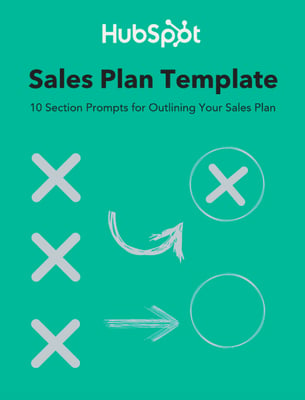 Image Source
Image Source
2. Sample Sales Plan by BestTemplates
Organizing your strategies and goals with a sales plan will make it easier for you and your sales team to stick to the targets you’ve set. This template is 9 pages long and includes a goals section before breaking down into more specific areas such as demand generation, implementation, and measurement and evaluation. This provides plenty of opportunity to create a concrete action plan.

Image Source
3. Asana Sales Plan
If you use Asana project management software, this template is for you. Embed this template where your team works and communicates to keep everyone aligned with your sales strategy. You’ll be able to see in real time the progress on all tasks on the way to your goals.
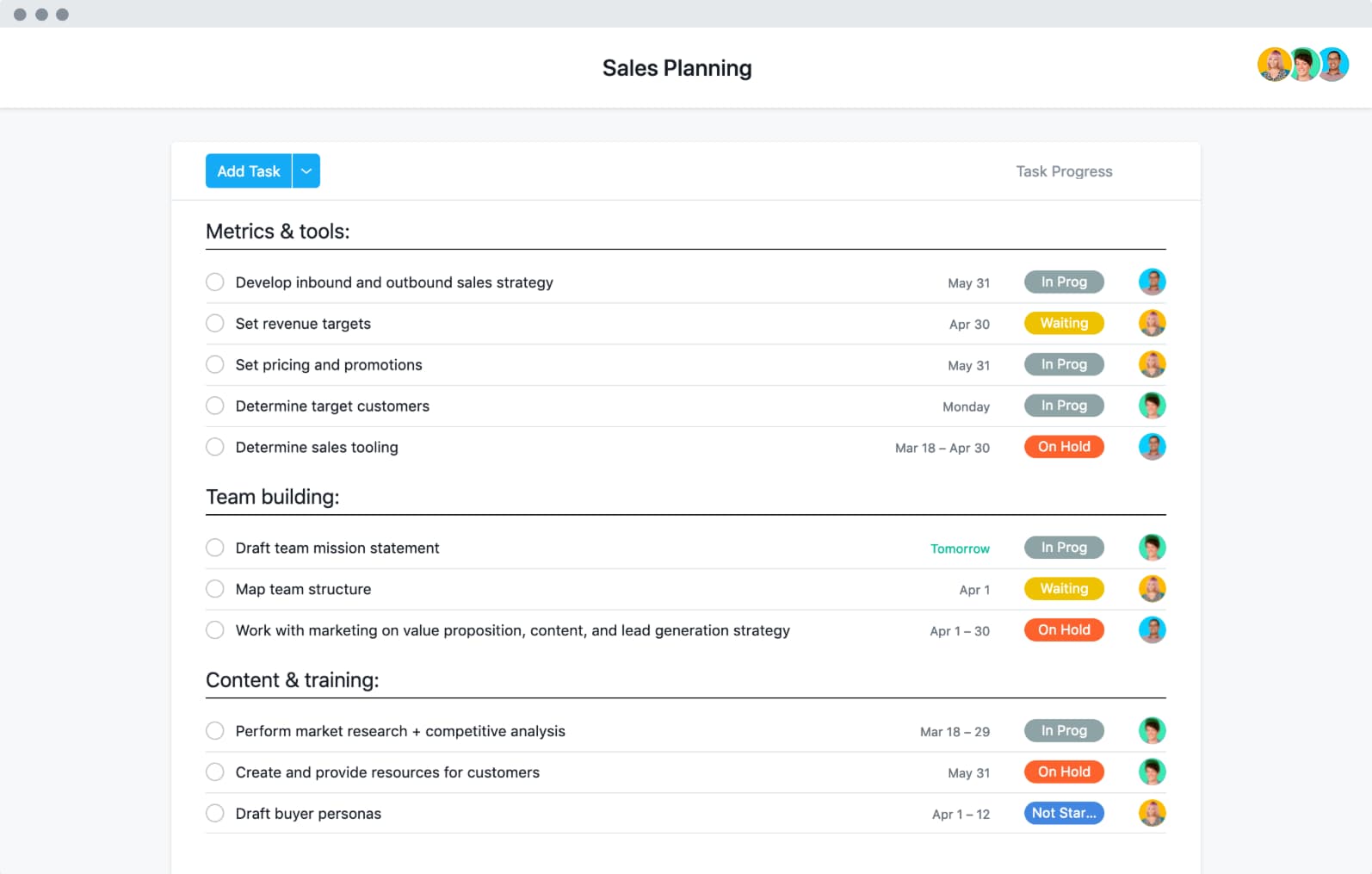 Image Source
Image Source
4. 1-Page Sales Plan by BestTemplates
A sales plan doesn’t need to be hundreds of pages long. Try consolidating your sales plan to a page or two. This template is a great example of making it short and sweet. In landscape mode, this strategic sales plan includes channel, expected costs and sales, distribution strategy, and key performance indicators in an easy-to-read grid layout.

Image Source
5. Online Sales Plan Maker Map by Venngage
Choose a design that fits your needs and create your sales plan using Venngage’s interface that includes custom charts, stock photos, and illustrations. You’ll have a number of visually interesting options, all available in just a single tool.
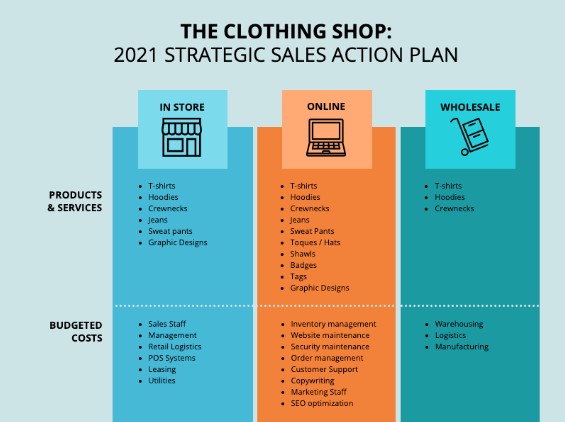 Image Source
Image Source
6. Small Business Sales Plan by FitSmallBusiness
If you run a small business, you may not have a fully stacked sales team yet. Establish a strong sales strategy for your company that future hires can build off of with this template. Sometimes simpler is better, so this plan relies on several standard sections to draw up your plan, with boxes that can be easily filled out using Microsoft Word or Google Docs.
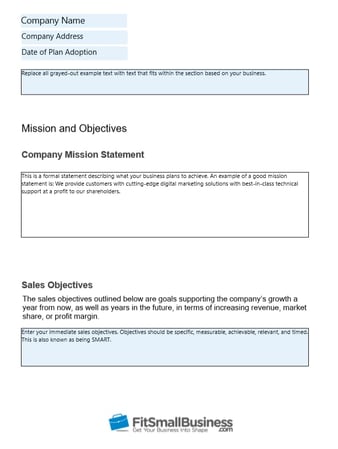 Image Source
Image Source
7. Sales Strategy Diagram from Creately
If you’re more of a visual person, creating a diagram for your sales strategy can be helpful. Use Creately to create an attractive sales strategy, breaking action items and values down by category.
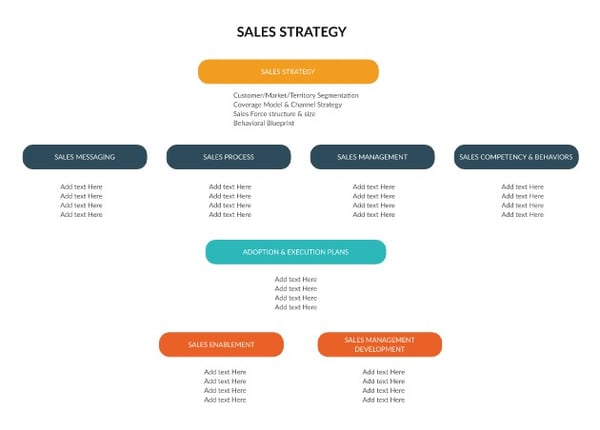 Image Source
Image Source
8. Sales Action Plan by BestTemplates
Dive into the details of your sales strategy with a sales action plan. With a minimalistic but super clean layout, this sales action plan focuses on the more concrete elements of achieving your sales goals such as positioning and strategic plays. It is 8 pages long and fully customizable in either Word or Pages.

Image Source
9. 30-60-90 Day Sales Plan by Template.Net
Customize your sales plan to set goals for the short-term and long-term. This sales plan does some of the work for you by outlining tasks related to your sales goals. You can check off boxes as you complete each item that’s provided to ensure you’re creating a sound sales strategy.
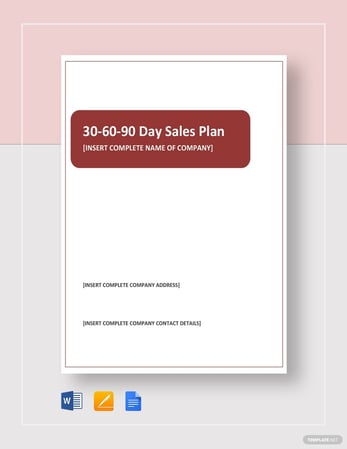
Image Source
10. Microsoft Word Sales Plan Template from TemplateLab
This template breaks down goals into action items, helps you think about how to assign responsibility, and gets you to commit to specific dates. The best part is that it focuses on multiple goals, allowing you a bird’s eye view on several initiatives you may be putting together.
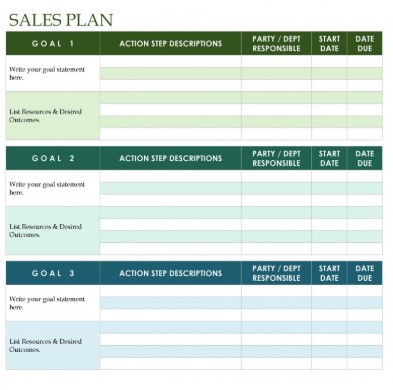 Image Source
Image Source
11. 90-Day Sales Plan by Template.Net
Look ahead at your sales strategies for the next 90 days using this sample sales plan. In this document, you’ll be able to break your sales plan down into phases, tasks, and key questions for your sales goals. The final section is a mind map for your sales process and pipeline strategies.
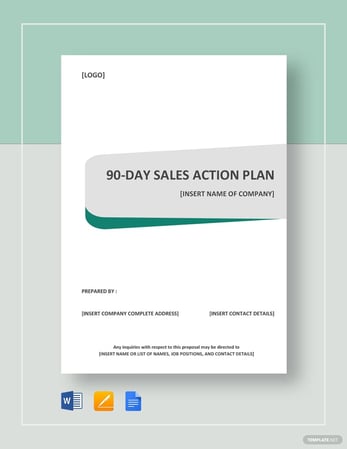
Image Source
There’s no one-size-fits-all sales plan. The only wrong way to use a sales plan is to write it at the start of the year or quarter and never touch it again; you should periodically review and even update it as time goes on to ensure you’re focused and on-track.
Editor’s note: This post was originally published in December 2019 and has been updated for comprehensiveness.
![]()

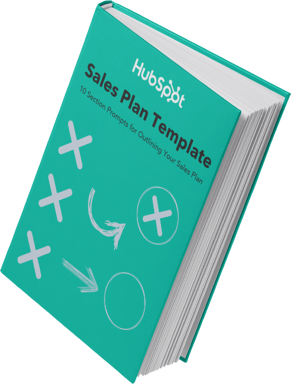
![Read more about the article 10 Best Sales Presentations To Inspire Your Sales Deck [+ 5 Tips]](https://www.dimaservices.agency/wp-content/uploads/2021/08/b6c8e5f1-c9df-4946-ab22-0d39da214e5a-1-300x42.png)
